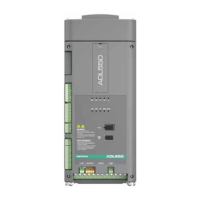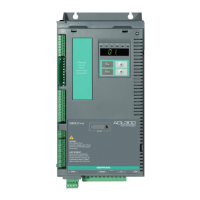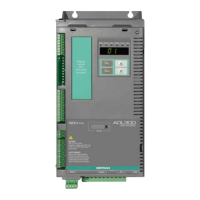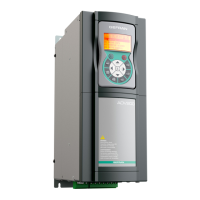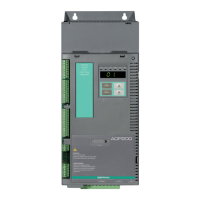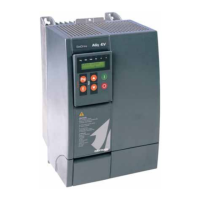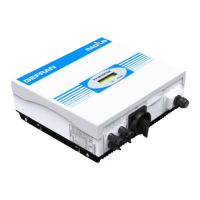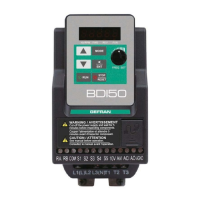ADL500 • Quick installation guide - Specifications and connection 77
10 - Troubleshooting
10.1 Alarms
When an Alarm is tripped, the Alarm LED lights up and Alarm appears on the display.
Note ! To reset alarms, see paragraph "8.2.11.1 Alarm reset" on page 57.
In the following table, the Code is visible only from GF_DriveLabs configurator.
Index Error message shown
on the display
Sub-code Description
0 No alarm Condition: No alarm present
1 Overvoltage Condition: DC link overvoltage alarm due to energy recovered from the motor.
The voltage arriving at the drive power section is too high compared to the maximum threshold relating to the PAR 560 Mains voltage parameter setting.
Solution:
- Extend the deceleration ramp.
- Use a braking resistor to dissipate the energy recuperation, to be connected to the specific terminals. See section "7.2.1 Power terminals and connection"
on page 27.
2 Undervoltage Condition: DC link undervoltage alarm.
The voltage arriving at the drive power section is too low compared to the minimum threshold relating to the 560 Mains voltage parameter setting due to:.
- the mains voltage being too low or overextended voltage drops.
- poor cable connections (e.g. loose contactor terminals, inductance, filter, etc. ).
Solution: Check the connections and mains voltage
3 Ground fault Condition: Ground short circuit alarm
Solution:
- Check drive and motor wiring.
- Check that the motor is not grounded.
4 Overcurrent Condition: Instantaneous overcurrent protection intervention alarm.
This may be due to the incorrect setting of current regulator parameters or a short circuit between phases or ground fault on the drive output.
Solution:
- Check the current regulator parameters (menu 12.3)
- Check wiring towards the motor
5 Desaturation Condition: Instantaneous overcurrent in the IGBT bridge alarm.
Solution:
- Switch the drive off and then switch it on again.
- Check the condition of the braking resistor isolation. Make sure there are no earth leakages.
- If the alarm persists, contact the technical service centre.
6 MultiUndervolt Condition: The number of attempted automatic restarts after the Undervoltage alarm has exceeded the set PAR 4650 UVRep attempts value in the PAR
4652 UVRep delay time.
Solution: Too many Undervoltage alarms.
Adopt the proposed solutions for the Undervoltage alarm.
7 MultiOvercurr Condition: 2 attempted automatic restarts after the Overcurrent alarm within 30 seconds. If more than 30 seconds pass after the Overcurrent alarm was
generated, the attempt counter is reset.
Solution: Too many Overcurrent alarms. Adopt the proposed solutions for the Overcurrent alarm.
8 MultiDesat Condition: 2 attempted at automatic restarts after the Desaturation alarm within 30 seconds. If more than 30 seconds pass after the Desaturation alarm
was generated, the attempt counter is reset.
Solution: Too many Desaturation alarms.
Adopt the proposed solutions for the Desaturation alarm.
9 Heatsink OT Condition: Heatsink temperature too high alarm
Solution:
- Verify the correct operation of the cooling fan.
- Check that the heatsinks are not clogged
- Check that the openings for the cabinet cooling air are not blocked.
10 HeatsinkS OTUT Condition: IGBT module temperature too high or too low alarm
Solution:
- Verify the correct operation of the cooling fan.
- Check that the heatsinks are not clogged
- Check that the openings for the cabinet cooling air are not blocked.
11 PTC failure Condition: PTC sensor break alarm.
Solution: Verificare il collegamento e l'integrità della sonda PTC.
12 Motor OT Condition: Motor overtemperature alarm. Possible causes:
- Load cycle too heavy
- The motor is installed in a place where the ambient temperature is too high
- If the motor is provided with a blower: the fan is not working
- If the motor is not provided with a blower: the load is too high at slow speeds. Cooling the fan on the motor shaft is not sufficient for this load cycle.
- The motor is used at less than the rated frequency, causing additional magnetic losses.
Solution:
- Change the processing cycle.
- Use a cooling fan to cool the motor.
